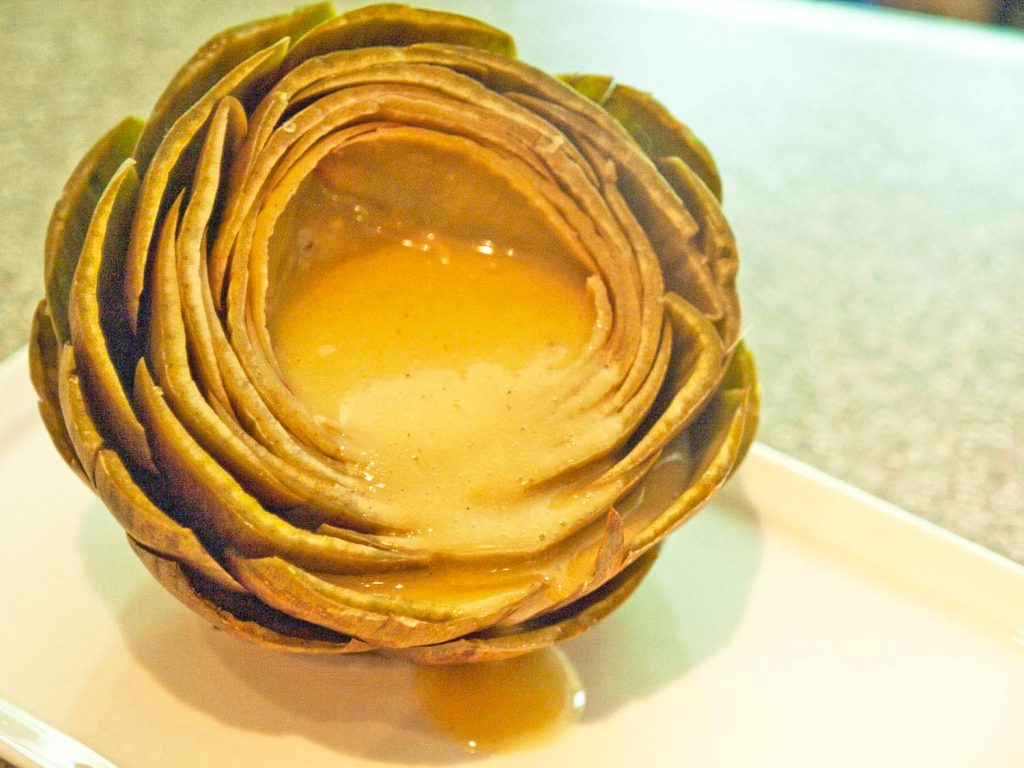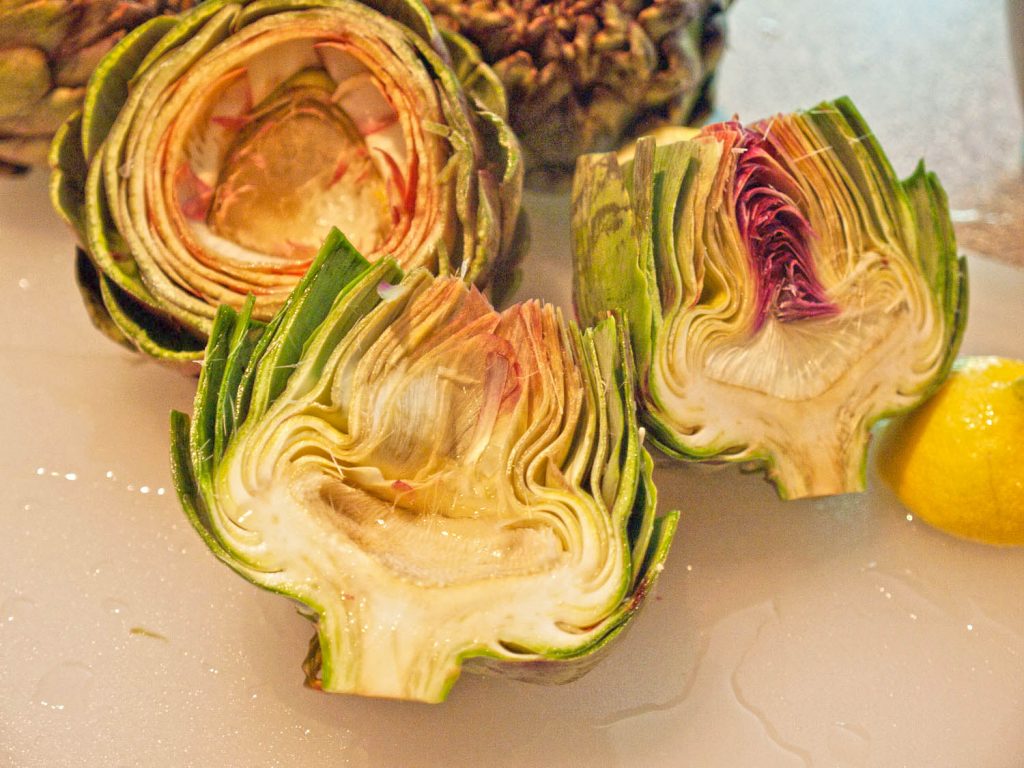Most people like artichokes; however, fresh artichokes have a reputation for being rather difficult, or unyielding, or downright ornery. Oh it’s no trouble to throw a few canned artichoke hearts into a pasta dish or soup. It’s a breeze to roast frozen artichoke hearts with a little Parmesan cheese. But when faced with the prickly exterior of a tough, street-wise artichoke, even the bravest cooks (and diners) have been known to shudder.
In her cookbook, Mastering the Art of French Cooking, Julia Child taught me to clean, cook and eat artichokes. She taught me to adore the prickly vegetable. She taught me that while artichokes are delicious, they are sublime when dipped in a classic French sauce. Julia taught me to be brave and to try as best I can to stifle my tendency towards melodrama.
I’m sharing with you today, Julia’s artichoke wisdom. She doesn’t recommend trussing cleaned artichokes with twine and securing a slice of lemon to the bottom for cooking. She frowns upon adding baking soda to the cooking water, “Any Frenchman would look with disfavor on a bright green boiled artichoke, knowing that baking soda had been added to the water.” She does not recommend wine with an artichoke course because “wine changes its character when drunk with this vegetable.” She gives simple, easy to follow instructions about how to choose, clean, cook and eat an artichoke. She recommends delicious buttery sauces to be served with warm artichokes and vinegary sauces for cold artichokes.

While aioli and hollandaise are both delicious sauces to dip your spring artichoke into, this lemon butter sauce really takes artichokes to the next level.
Julia recommends Hollandaise or lemon butter sauce for warm artichokes. She instructs us to pull the leaves apart and spoon the sauce into the cavity of the warm artichoke. As far as I’m concerned, there is nothing better, but everyone has his or her own preferences, so here are some more ideas:
- Melted butter
- Garlic mayonnaise
- Honey Mustard
Julia didn’t share a recipe for grilling artichokes, that one is mine. To tell you the truth I find it much easier to remove the choke after the artichoke has been sliced in half and putting par-cooked artichokes on the grill was my way of covering up my less than perfect cleaning job. Turns out, they are delicious grilled and drizzled with a bit of aged balsamic vinegar. I think Julia would approve.
Embrace this spring thistle and the artichoke etiquette that goes along with fresh artichokes: Dip, nibble and enjoy.
How to Select, Clean, Cook and Eat an Artichoke
Select:
Look for green or purple tinged leaves that are tight
White or brown streaks indicate frost bite; not pretty but still tasty
Squeeze it; it should squeak and not be spongy.
Clean:

Use a spoon to scrape the fuzzy purple choke from the heart of the artichoke.
Prepare a bowl of acidulated water. Julia Child recommends 1 Tablespoon of vinegar or lemon juice per quart of water.
Using a sharp, heavy knife cut off the stem right at the bottom of the artichoke.
Then cut off between ¾ and 1” off the top of the artichoke. Use scissors to trim the points off the rest of the leaves.
Give is a swish in the acidulated water
Remove any damaged leaves
Pull apart the artichoke to expose the purple center cone of leaves, pull them out and discard. You will see a fuzzy choke in the center. Use a spoon (a grapefruit spoon works great) to remove the entire fuzzy choke. The cavity should be smooth. Or:
Slice the artichoke in half to expose the center cone of purple leaves and the fuzzy choke. Remove the leaves and use a spoon to remove the choke. This is the way I prefer to do it.
Keep the artichoke in the bowl of acidulated water until all of your artichokes are cleaned and ready for cooking.
Cook:
Bring a large pot of salted water to a rolling boil.
Toss in the artichokes and boil gently. A whole artichoke needs to boil between 30-40 minutes. A halved artichoke needs only about 20.
The artichoke is done when you can easily pull out a leaf with no tugging.
Eat:
Pull off a leaf from the outside of your artichoke.
Dip the bottom of the leaf in whatever sauce you have chosen.
Scrape off the tender flesh at the bottom of the leaf with your teeth. If the meat doesn’t come off easily, cook the artichoke a little longer.
Discard the leaves. They are not edible. I do not put artichoke leaves down my garbage disposal. I’ve never been told it is a no-no, but I’d rather be safe than sorry.
Work your way, leaf by leaf toward the tender, inner leaves and artichoke bottom/heart. Use a knife and fork to enjoy this delightful morsel.
Grilled Artichokes
Clean the artichoke as described above. Cut it in half.
Par-cook the artichoke in boiling, salted water for 15 minutes. Remove from the water and let dry a bit.
Coat the artichoke with oil.
Grill over medium high heat, cut side down, for 5 to 6 minutes. Serve immediately.
I like to drizzle balsamic vinaigrette over grilled artichokes.
Julia Child’s Beurre au Citron
(Lemon Butter Sauce)
Yield: about ½ cup
- ¼ cup freshly squeezed lemon juice
- 1/8 teaspoon of salt
- Pinch of white pepper
- 1 stick of chilled, unsalted butter, cut into 8 pieces
Place the lemon juice, salt and pepper in a saucepan and boil down until it has reduced to 1 tablespoon. The mixture will darken.
Remove from the heat and immediately beat in 2 pieces of chilled butter. Set over very low heat and beat in the rest of the butter, a piece at a time, to make a thick, creamy sauce. When all the butter has been beaten in, remove from the heat immediately.
If the mixture thickens before service, beat in 1 or 2 Tablespoons of hot water.











